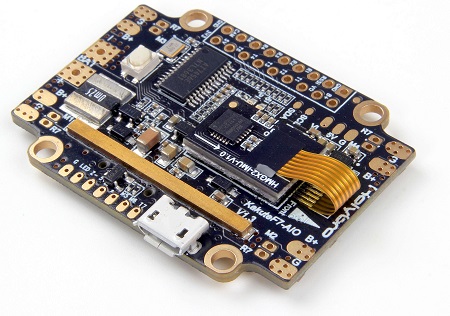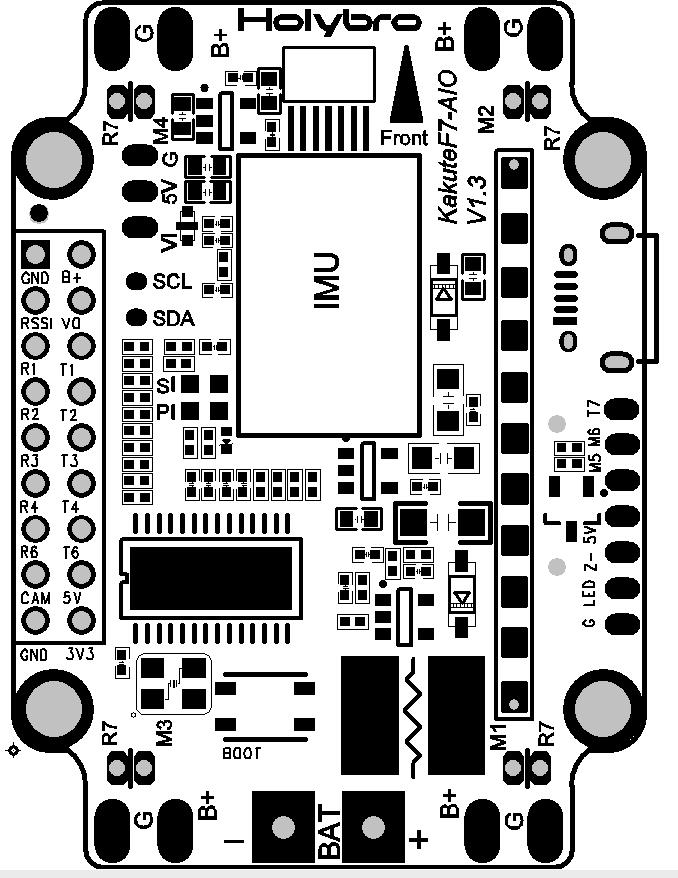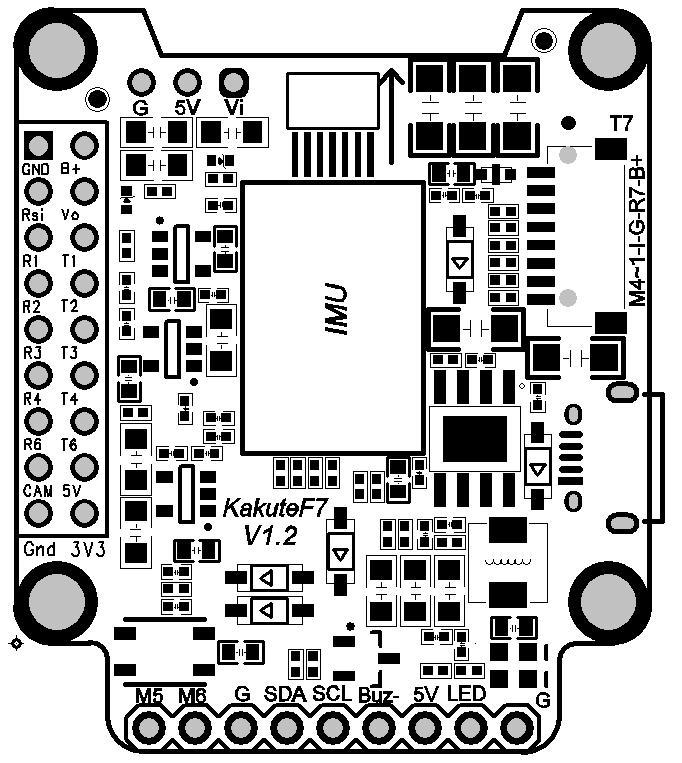Holybro Kakute F7 and KAKUTE F7 AIO¶

above image and some content courtesy of Holybro
Note
Support for these two boards are available with Copter-3.6.0 (and higher)
Note
Due to flash memory limitations, this board does not include all ArduPilot features. See Firmware Limitations for details.
Specifications¶
Processor
STM32F745 32-bit processor
Sensors
InvenSense ICM20689 IMU (accel and gyro only, no compass) on vibration isolating foam
BMP280 barometers
Power
7V ~ 42V input power directly from battery
Current Sensor up to 120A maximum continuous current on the All-in-One version
Interfaces
6x PWM outputs
1x RC input SBUS/PPM
5x UARTs/serial for GPS and other peripherals
1x I2C port for external compass
micro USB port
All UARTS support hardware inversion. SBUS, SmartPort, and other inverted protocols work on any UART without “uninvert hack”
microSD Card Slot for logging
AT7456E OSD
2A 5v regulator
Pinout¶
The KakuteF7 comes in two variants with the primary difference being the AIO (All-In-One) board employs current sensor and provides power distribution in each of the four corners. Both variants include a 5-volt regulator rated for 2 amps, OSD, vibration-isolated IMU, etc.
Kakute F7 AIO

Kakute F7

UART Mapping¶
The UARTs are marked Rn and Tn in the above pinouts. The Rn pin is the receive pin for UARTn. The Tn pin is the transmit pin for UARTn.
SERIAL0 -> USB
SERIAL1 -> UART1 (Telem1)
SERIAL2 -> UART2 (Telem2)
SERIAL3 -> UART3 (GPS)
SERIAL4 -> UART4
SERIAL5 -> UART7
SERIAL6 -> UART6 (TX only unless BRD_ALT_CONFIG = 1, then RX available also)
The SERIAL5 port (UART7) is normally for ESC telemetry, and has an R7 pad on each of the four corners of the KakuteF7 AIO board.
Servo Output Mapping¶
The PWM outputs are marked M1-M6 in the above pinouts. The corresponding servo outputs are:
M1 -> Servo Output 4
M2 -> Servo Output 1
M3 -> Servo Output 2
M4 -> Servo Output 3
M5 -> Servo Output 5
M6 -> Servo Output 6
RC Input¶
The R6 pin, which by default is mapped to a timer input, can be used for all ArduPilot supported receiver protocols, except CRSF/ELRS and SRXL2 which require a true UART connection. However, FPort, when connected in this manner, will only provide RC without telemetry.
To allow CRSF and embedded telemetry available in Fport, CRSF, and SRXL2 receivers, the R6 pin can also be configured to be used as true UART RX pin for use with bi-directional systems by setting the BRD_ALT_CONFIG to “1” so it becomes the SERIAL6 port’s RX input pin.
With this option, SERIAL6_PROTOCOL must be set to “23”, and:
PPM is not supported.
SBUS/DSM/SRXL connects to the R6 pin, but SBUS requires that the SERIAL6_OPTIONS be set to “3”.
FPort requires connection to T6 and SERIAL6_OPTIONS be set to “7”.
CRSF also requires a T6 connection, in addition to R6, and automatically provides telemetry. Set SERIAL6_OPTIONS to “0”.
SRXL2 requires a connection to T6 and automatically provides telemetry. Set SERIAL6_OPTIONS to “4”.
Any UART can be used for RC system connections in ArduPilot also, and is compatible with all protocols except PPM. See Radio Control Systems for details.
FrSky Telemetry¶
FrSky Telemetry is supported using the T6 pin (UART6 transmit). You need to set the following parameters to enable support for FrSky S.PORT
OSD Support¶
The KakuteF7 AIO supports OSD using OSD_TYPE 1 (MAX7456 driver).
PWM Output¶
The KakuteF7 supports up to 6 PWM outputs. The pads for motor output M1 to M6 on the above diagram are for the 6 outputs. All 6 outputs support DShot as well as all PWM types.
The PWM is in 3 groups:
PWM 1, 2 and 3 in group1
PWM 4 and 5 in group2
PWM 6 in group3
Channels within the same group need to use the same output rate, whether PWM or Dshot. If any channel in a group uses DShot then all channels in the group need to use DShot.
Battery Monitoring¶
The AIO board has a built-in current sensor. The current sensor can read up to 130 Amps. The voltage sensor can handle up to 6S LiPo batteries.
The correct battery setting parameters are:
BATT_VOLT_MULT 10.1
BATT_AMP_PERVLT 17.0
Compass¶
The Kakute F7 and Kakute F7 AIO do not have a built-in compass, however you can attach an external compass using I2C on the SDA and SCL pads.
Loading Firmware¶
Initial firmware load can be done with DFU by plugging in USB with the bootloader button pressed. Then you should load the “with_bl.hex” firmware, using your favourite DFU loading tool.
Once the initial firmware is loaded you can update the firmware using any ArduPilot ground station software. Updates should be done with the *.apj firmware files.
Where to Buy¶
Available from many retailers including Holybro Kakute F7 AIO , Holybro Kakute F7 V1.5 and Holybro Kakute F7 HDV
Firmware¶
Firmware for this board can be found here in sub-folders labeled “KakuteF7”.
Firmware for this board which supports bi-directional Dshot is labeled “KakuteF7-bdshot”.
Note
Output 5 is disabled in bi-directional Dshot firmware and Output 6 only supports normal Dshot and PWM.